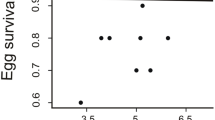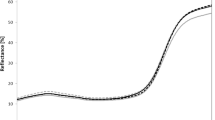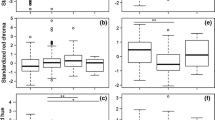Abstract
Males in many bird species develop elaborate carotenoid-based plumage ornaments which often play an important role as signals of individual quality in intra- or intersexual selection. However, knowledge of the pattern of age-related variation in plumage traits is crucial to interpret results on associations between plumage signals and reproductive performance. We investigated how age is related to brightness and carotenoid saturation of the orange-red breeding plumage in males of known age in the Red Bishop (Euplectes orix), a polygynous and sexually dimorphic weaverbird species. We found that the relationships of both plumage brightness and carotenoid saturation with age were best explained by a quadratic function, with males in their prime (i.e. 3–5 years old) having a brighter and more carotenoid-saturated plumage than both very young and very old males. The implications of our results for studies in the context of animal signalling are discussed.
Zusammenfassung
Altersabhängige Variation von karotenoid-basierter Gefiederfärbung bei Männchen des Oryxwebers (Euplectes orix)
Die Männchen vieler Vogelarten entwickeln auffällige karotenoid-basierte Gefiedermerkmale welche oft auch eine wichtige Rolle als Signale im Kontext intra- und intersexueller Selektion spielen. Eine wichtige Voraussetzung für die Untersuchung von Zusammenhängen zwischen Gefiedermerkmalen und Fortpflanzungserfolg ist jedoch eine genaue Kenntnis der altersabhängigen Variation dieser Gefiedermerkmale. In dieser Studie haben wir untersucht, wie Alter mit Glanz und Farbsättigung des orange-roten Brutgefieders von Männchen des Oryxwebers (Euplectes orix), einer polygynen und stark sexuell dimorphen Webervogelart, zusammenhängt. Es ergab sich, dass sowohl der Zusammenhang zwischen Alter und Gefiederglanz als auch der Zusammenhang zwischen Alter und Farbsättigung am besten mit einer quadratischen Funktion erklärt werden kann. Das Gefieder von Männchen im besten Fortpflanzungsalter (d.h. Männchen im Alter zwischen 3 und 5 Jahren) weist einen höheren Glanz und auch eine höhere Farbsättigung auf als das Gefieder von sehr jungen oder sehr alten Männchen. Die Implikationen unserer Ergebnisse für Studien zu Signalen im Tierreich werden diskutiert.


Similar content being viewed by others
References
Andersson S, Amundsen T (1997) Ultraviolet colour vision and ornamentation in bluethroats. Proc R Soc Lond B 264:1587–1591
Andersson S, Prager M (2006) Quantifying colors. In: Hill GE, McGraw KJ (eds) Bird coloration: mechanisms and measurements, vol 1. Harvard University Press, Cambridge, pp 41–89
Armenta JK, Dunn PO, Whittingham LA (2008) Quantifying avian sexual dichromatism: a comparison of methods. J Exp Biol 211:2423–2430
Bitton PP, Dawson RD (2008) Age-related differences in plumage characteristics of male tree swallows Tachycineta bicolor: hue and brightness signal different aspects of individual quality. J Avian Biol 39:446–452
Bitton PP, O’Brien EL, Dawson RD (2007) Plumage brightness and age predict extrapair fertilization success of male tree swallows, Tachycineta bicolor. Anim Behav 74:1777–1784
Blount JD, Metcalfe NB, Birkhead TR, Surai PF (2003) Carotenoid modulation of immune function and sexual attractiveness in zebra finches. Science 300:125–127
Bonneaud C, Mazuc J, Chastel O, Westerdahl H, Sorci G (2004) Terminal investment induced by immune challenge and fitness traits associated with major histocompatibility complex in the house sparrow. Evolution 58:2823–2830
Brooks R, Kemp DJ (2001) Can older males deliver the good genes? Trends Ecol Evol 16:308–313
Budden AE, Dickinson JL (2009) Signals of quality and age: the information content of multiple plumage ornaments in male western bluebirds Sialia mexicana. J Avian Biol 40:18–27
Clutton-Brock TH (1984) Reproductive effort and terminal investment in iteroparous animals. Am Nat 123:212–229
Collis K, Borgia G (1992) Age-related effects of testosterone, plumage, and experience on aggression and social dominance in juvenile male satin bowerbirds (Ptilonorhynchus violaceus). Auk 109:422–434
Cote J, Arnoux E, Sorci G, Gaillard M, Faivre B (2010) Age-dependent allocation of carotenoids to coloration versus antioxidant defences. J Exp Biol 213:271–277
Cuthill IC, Bennett ATD, Patridge JC, Maier EJ (1999) Plumage reflectance and the objective assessment of avian sexual dichromatism. Am Nat 153:183–200
Del Val E, Quesada J, Senar JC (2010) Age-related differences in a carotenoid-based coloration trait are due to within-individual changes in great tits Parus major. Ardea 98:179–184
Delhey K, Kempenaers B (2006) Age differences in blue tit Parus caeruleus plumage colour: within-individual changes or colour-biased survival? J Avian Biol 37:339–348
Delhey K, Roberts ML, Peters A (2010) The carotenoid-continuum: carotenoid-based plumage ranges from conspicuous to cryptic and back again. BMC Ecology 10:13
Eaton MD (2005) Human vision fails to distinguish widespread sexual dichromatism among sexually ‘‘monochromatic’’ birds. Proc Natl Acad Sci USA 102:10942–10946
Edler AU, Friedl TWP (2010a) Individual quality and carotenoid-based plumage ornaments in male red bishops (Euplectes orix): plumage is not all that counts. Biol J Linn Soc 99:384–397
Edler AU, Friedl TWP (2010b) Plumage colouration, age, testosterone and dominance in male red bishops (Euplectes orix): a laboratory experiment. Ethology 116:806–820
Evans SR, Hinks AE, Wilkin TA, Sheldon BC (2010) Age, sex and beauty: methodological dependence of age- and sex-dichromatism in the great tit Parus major. Biol J Linn Soc 101:777–796
Ferns PN, Hinsley SA (2008) Carotenoid plumage hue and chroma signal different aspects of individual and habitat quality in tits. Ibis 150:152–159
Freeman-Gallant CR, Taff CC, Morin DF, Dunn PO, Whittingham LA, Tsang SM (2010) Sexual selection, multiple male ornaments, and age- and condition-dependent signalling in the common yellowthroat. Evolution 64:1007–1017
Friedl TWP (2004) Breeding behaviour of the red bishop (Euplectes orix): a synthesis and new observations. Vogelwarte 42:178–190
Friedl TWP, Klump GM (1999) Determinants of male mating success in the red bishop (Euplectes orix). Behav Ecol Sociobiol 46:387–399
Galván I, Møller AP (2009) Different roles of natural and sexual selection on senescence of plumage colour in the barn swallow. Funct Ecol 23:302–309
Griffith SC, Owens IPF, Thuman KA (2002) Extra pair paternity in birds: a review of interspecific variation and adaptive function. Mol Ecol 11:2195–2212
Grill CP, Rush VN (2000) Analysing spectral data: comparison and application of two techniques. Biol J Linn Soc 69:121–138
Haussmann MF, Winkler DW, Huntington CE, Vleck D, Sanneman CE, Hanley D, Vleck CM (2005) Cell-mediated immunosenescence in birds. Oecologia 145:270–275
Hill GE (1996) Subadult plumage in the house finch and tests of models for the evolution of delayed plumage maturation. Auk 113:858–874
Hill GE (2006) Female mate choice for ornamental coloration. In: Hill GE, McGraw KJ (eds) Bird coloration: function and evolution, vol 2. Harvard University Press, Cambridge, pp 137–200
Hill GE, McGraw KJ (2006) Bird coloration, vol 2: function and evolution. Harvard University Press, Cambridge
Huggins KA, Navara KJ, Mendonca MT, Hill GE (2010) Detrimental effects of carotenoid pigments: the dark side of bright coloration. Naturwissenschaften 97:637–644
Johnstone RA (1995) Sexual selection, honest advertisement and the handicap principle, reviewing the evidence. Biol Rev 70:1–65
Keyser AJ, Hill GE (1999) Condition-dependent variation in the blue-ultraviolet coloration of a structurally based plumage ornament. Proc R Soc Lond B 266:771–777
Kokko H (1998) Good genes, old age, and life history trade-offs. Evol Ecol 12:739–750
Komdeur J, Oorebeek M, van Overveld T, Cuthill IC (2005) Mutual ornamentation, age, and reproductive performance in the European starling. Behav Ecol 16:805–817
Krinsky NI (1994) The biological properties of carotenoids. Pure Appl Chem 66:1003–1010
Lawes MJ, Slotow R, Andersson S (2002) Male nest building but not display behaviour directly influences mating success in the polygynous red bishop (Euplectes orix). Ostrich 73:87–91
Lessells CM, Boag PT (1987) Unrepeatable repeatabilities: a common mistake. Auk 104:116–121
Manning JT (1985) Choosy females and correlates of male age. J Theor Biol 116:349–395
McGraw KJ (2005) The antioxidant function of many animal pigments: are there consistent health benefits of sexually selected colourants? Anim Behav 69:757–764
McGraw KJ, Ardia DR (2003) Carotenoids, immunocompetence, and the information content of sexual colors: an experimental test. Am Nat 162:704–712
McGraw KJ, Hudon J, Hill GE, Parker RS (2005) A simple and inexpensive chemical test for behavioral ecologists to determine the presence of carotenoid pigments in animal tissues. Behav Ecol Sociobiol 57:391–397
Metz M, Klump GM, Friedl TWP (2009) Male nest-building behaviour and mating success in the red bishop (Euplectes orix). Behaviour 146:771–794
Møller AP, Biard C, Blount JD, Houston DC, Ninni P, Saino N, Surai PF (2000) Carotenoid-dependent signals: indicators of foraging efficiency, immunocompetence, or detoxification ability? Avian Poult Biol Rev 11:137–159
Montgomerie R (2006) Analyzing colors. In: Hill GE, McGraw KJ (eds) Bird coloration: mechanisms and measurements, vol 1. Harvard University Press, Cambridge, pp 90–147
Olson VA, Owens IPF (1998) Costly sexual signals: are carotenoids rare, risky or required? Trends Ecol Evol 13:510–514
Poston JP (1997) Dominance, access to colonies, and queues for mating opportunities by male boat-tailed grackles. Behav Ecol Sociobiol 41:89–98
Probst JR, Donner DM, Bozek MA (2007) Continuous, age-related plumage variation in male Kirtland’s warblers. J Field Ornithol 78:100–108
Prum RO (2006) Anatomy, physics, and evolution of avian structural colors. In: Hill GE, McGraw KJ (eds) Bird coloration: mechanisms and measurements, vol 1. Harvard University Press, Cambridge, pp 295–353
Pryke SR, Andersson S (2003) Carotenoid-based status signalling in red-shouldered widowbirds (Euplectes axillaris): epaulet size and redness affect captive and territorial competition. Behav Ecol Sociobiol 53:393–401
Pryke SR, Andersson S, Lawes MJ, Piper SE (2002) Carotenoid status signaling in captive and wild red-collared widowbirds: independent effects of badge size and color. Behav Ecol 13:622–631
Richardson DS, Burke T (1999) Extrapair paternity in relation to age in Bullocks orioles. Mol Ecol 8:2115–2126
Rohwer S, Fretwell SD, Niles DM (1980) Delayed maturation in passerine plumages and the deceptive acquisition of resources. Am Nat 115:400–437
Senar JC (2006) Color displays as intrasexual signals of aggression and dominance. In: Hill GE, McGraw KJ (eds) Bird coloration: function and evolution, vol 2. Harvard University Press, Cambridge, pp 87–136
Sergio F, Blas J, Hiraldo F (2009) Predictors of floater status in a long-lived bird: a cross-sectional and longitudinal test of hypotheses. J Anim Ecol 78:109–118
Shawkey MD, Hill GE (2005) Carotenoids need structural colours to shine. Biol Lett 1:121–124
Siefferman LM, Hill GE, Dobson FS (2005) Ornamental plumage coloration and condition are dependent on age in eastern bluebirds Sialia sialis. J Avian Biol 36:428–435
Siitari H, Huhta E (2002) Individual color variation and male quality in pied flycatchers (Ficedula hypoleuca): a role of ultraviolet reflectance. Behav Ecol 13:737–741
Smith JNM, Montgomerie RD, Taitt MJ, Yom-Tov Y (1980) A winter feeding experiment on an island song sparrow population. Oecologia 47:164–170
Stahl J, Tolsma PH, Maarten JJE, Drent RH (2001) Subordinates explore but dominants profit: resource competition in high Arctic barnacle goose flocks. Anim Behav 61:257–264
Sundberg J (1995) Parasites, plumage coloration and reproductive success in the yellowhammer, Emberiza citronella. Oikos 74:331–339
Sundberg J, Dixon A (1996) Old, colourful male yellowhammers, Emberiza citrinella, benefit from extra-pair copulations. Anim Behav 52:113–122
Sundberg J, Larsson C (1994) Male coloration as an indicator of parental quality in the yellowhammer, Emberizy citrinella. Anim Behav 48:885–892
Velando A, Drummond H, Torres R (2006) Senescent birds redouble reproductive effort when ill: confirmation of the terminal investment hypothesis. Proc R Soc Lond B 273:1443–1448
Vorobyev M, Osorio D, Bennett ATD, Marshall NJ, Cuthill IC (1998) Tetrachromacy, oil droplets and bird plumage colours. J Comp Physiol A 183:621–633
Acknowledgments
We would like to thank the National Parks Board of South Africa and the Chief Directorate Environmental Affairs at the Department of Economic Affairs, Environment and Tourism in the Eastern Cape Province for the permission to carry out this study in the Addo Elephant National Park. We are also grateful to Janis Dickinson, Alain Jacot and two anonymous reviewers for constructive comments on a previous version of the manuscript, to Ralf Edler for his help with the field work, and to the entire staff at the Addo Elephant National Park for their continuous support. Alice Edler was supported by a grant from the DAAD (Deutscher Akademischer Austauschdienst). This study was funded by the Deutsche Forschungsgemeinschaft (DFG FR 2096/2-2).
Author information
Authors and Affiliations
Corresponding author
Additional information
Communicated by F. Bairlein.
Rights and permissions
About this article
Cite this article
Edler, A.U., Friedl, T.W.P. Age-related variation in carotenoid-based plumage ornaments of male Red Bishops Euplectes orix . J Ornithol 153, 413–420 (2012). https://doi.org/10.1007/s10336-011-0757-3
Received:
Revised:
Accepted:
Published:
Issue Date:
DOI: https://doi.org/10.1007/s10336-011-0757-3




